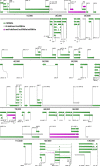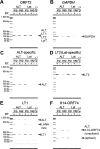Expression of the Antisense-to-Latency Transcript Long Noncoding RNA in Kaposi's Sarcoma-Associated Herpesvirus
- PMID: 27928018
- PMCID: PMC5286886
- DOI: 10.1128/JVI.01698-16
Expression of the Antisense-to-Latency Transcript Long Noncoding RNA in Kaposi's Sarcoma-Associated Herpesvirus
Abstract
The regulation of latency is central to herpesvirus biology. Recent transcriptome-wide surveys have uncovered evidence for promiscuous transcription across the entirety of the Kaposi's sarcoma-associated herpesvirus (KSHV) genome and postulated the existence of multiple viral long noncoding RNAs (lncRNAs). Next-generation sequencing studies are highly dependent on the specific experimental approach and particular algorithms of analysis and therefore benefit from independent confirmation of the results. The antisense-to-latency transcript (ALT) lncRNA was discovered by genome-tiling microarray (Chandriani et al., J Virol 86:7934-7942, 2010, https://doi.org/10.1128/JVI.00645-10). To characterize ALT in detail, we physically isolated this lncRNA by a strand-specific hybrid capture assay and then employed transcriptome sequencing and novel reverse transcription-PCR (RT-PCR) assays to distinguish all RNA species in the KSHV latency region. These methods confirm that ALT initiates at positions 120739/121012 and encodes a single splice site, which is shared with the 3'-coterminal K14-vGPCR/ORF74 mRNA, terminating at 130873 (GenBank accession number GQ994935), resulting in an ∼10,000-nucleotide transcript. No shorter ALT isoforms were identified. This study also identified a novel intron within the LANA 5' untranslated region using a splice acceptor at 127888. In summary, ALT joins PAN/nut1/T1.1 as a bona fide lncRNA of KSHV with potentially important roles in viral gene regulation and pathogenesis.
Importance: Increasing data support the importance of noncoding RNAs (ncRNAs), including microRNAs (miRNAs) and lncRNAs, which have been shown to exert critical regulatory functions without coding for recognizable proteins. Defining the sequences of these ncRNAs is essential for future studies aiming to functionally characterize a specific ncRNA. Most lncRNA studies are highly dependent on high-throughput sequencing and bioinformatic analyses, few studies follow up on the initial predictions, and analyses are at times discordant. The manuscript characterizes one key viral lncRNA, ALT, by physically isolating ALT and by a sequencing-independent assay. It provides for a simple assay to monitor lncRNA expression in experimental and clinical samples. ALT is expressed antisense to the major viral latency transcripts encoding LANA as well as the viral miRNAs and thus has the potential to regulate this key part of the viral life cycle.
Keywords: ALT; KSHV; Kaposi's sarcoma-associated herpesvirus; LANA; RNA enrichment; antisense-to-latency transcripts; gene expression; herpesvirus; latency; lncRNA; long noncoding RNA.
Copyright © 2017 American Society for Microbiology.
Figures






Similar articles
-
The Expression and Nuclear Retention Element of Polyadenylated Nuclear RNA Is Not Required for Productive Lytic Replication of Kaposi's Sarcoma-Associated Herpesvirus.J Virol. 2021 Jun 10;95(13):e0009621. doi: 10.1128/JVI.00096-21. Epub 2021 Jun 10. J Virol. 2021. PMID: 33853955 Free PMC article.
-
Transcriptome analysis of Kaposi's sarcoma-associated herpesvirus during de novo primary infection of human B and endothelial cells.J Virol. 2015 Mar;89(6):3093-111. doi: 10.1128/JVI.02507-14. Epub 2014 Dec 31. J Virol. 2015. PMID: 25552714 Free PMC article.
-
Identification of Novel Kaposi's Sarcoma-Associated Herpesvirus Orf50 Transcripts: Discovery of New RTA Isoforms with Variable Transactivation Potential.J Virol. 2016 Dec 16;91(1):e01434-16. doi: 10.1128/JVI.01434-16. Print 2017 Jan 1. J Virol. 2016. PMID: 27795414 Free PMC article.
-
New insights into the expression and functions of the Kaposi's sarcoma-associated herpesvirus long noncoding PAN RNA.Virus Res. 2016 Jan 2;212:53-63. doi: 10.1016/j.virusres.2015.06.012. Epub 2015 Jun 21. Virus Res. 2016. PMID: 26103097 Free PMC article. Review.
-
Long non-coding RNA and epigenetic gene regulation of KSHV.Viruses. 2014 Nov 4;6(11):4165-77. doi: 10.3390/v6114165. Viruses. 2014. PMID: 25375882 Free PMC article. Review.
Cited by
-
Gammaherpesvirus Readthrough Transcription Generates a Long Non-Coding RNA That Is Regulated by Antisense miRNAs and Correlates with Enhanced Lytic Replication In Vivo.Noncoding RNA. 2019 Jan 10;5(1):6. doi: 10.3390/ncrna5010006. Noncoding RNA. 2019. PMID: 30634714 Free PMC article.
-
The Structure-To-Function Relationships of Gammaherpesvirus-Encoded Long Non-Coding RNAs and Their Contributions to Viral Pathogenesis.Noncoding RNA. 2018 Sep 26;4(4):24. doi: 10.3390/ncrna4040024. Noncoding RNA. 2018. PMID: 30261651 Free PMC article. Review.
-
Connivance, Complicity, or Collusion? The Role of Noncoding RNAs in Promoting Gammaherpesvirus Tumorigenesis.Trends Cancer. 2018 Nov;4(11):729-740. doi: 10.1016/j.trecan.2018.09.005. Epub 2018 Oct 10. Trends Cancer. 2018. PMID: 30352676 Free PMC article. Review.
-
Long Non-coding RNAs in Gammaherpesvirus Infections: Their Roles in Tumorigenic Mechanisms.Front Microbiol. 2021 Jan 15;11:604536. doi: 10.3389/fmicb.2020.604536. eCollection 2020. Front Microbiol. 2021. PMID: 33519750 Free PMC article. Review.
-
From enhancers to genome conformation: complex transcriptional control underlies expression of a single herpesviral gene.bioRxiv [Preprint]. 2024 Jun 16:2023.07.08.548212. doi: 10.1101/2023.07.08.548212. bioRxiv. 2024. Update in: Mol Syst Biol. 2025 Jan;21(1):30-58. doi: 10.1038/s44320-024-00075-0. PMID: 37461644 Free PMC article. Updated. Preprint.
References
-
- Damania B, Cesarman E. 2013. Kaposi's sarcoma-associated herpesvirus, p 2080–2128. In Fields BN, Knipe DM, Howley PM (ed), Fields virology, 6th ed Wolters Kluwer Health/Lippincott Williams & Wilkins, Philadelphia, PA.
-
- Kaplan LD. 2013. Human herpesvirus-8: Kaposi sarcoma, multicentric Castleman disease, and primary effusion lymphoma. Hematol Am Soc Hematol Educ Program 2013:103–108. - PubMed
Publication types
MeSH terms
Substances
Grants and funding
LinkOut - more resources
Full Text Sources
Other Literature Sources

